Motional emf
Problem:
In the figure below, assume
that R = 6 Ω, d = 1.2 m, and a uniform 2.5 T magnetic field is directed into the
page. At what speed should the bar be moved to produce 0.5 A in the
resistor?
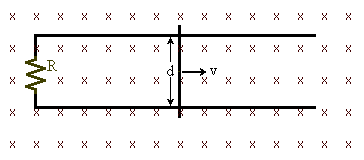
Solution:
- Concepts:
Motional emf
- Reasoning:
The emf is generated by sliding the conducting rod in a direction
perpendicular to the magnetic field
- Details of the calculation:
The emf driving the current is equal to vBd where d is the length of the
section of wire connecting the rails. (The work done per unit charge
(voltage) is vBd, when a charge moves from one end of the moving wire to the
other end.) The current flowing in the circuit will be I = vBd/R,
where R is the resistance of the circuit.
Therefore v = IR/Bd = 0.5 A*6 Ω/(2.5 T*1.2 m) = 1 m/s.
Problem:
A pair of parallel conducting rails a distance d apart is placed in a
uniform magnetic field B which is perpendicular to the rails. A
resistance R is connected across the rails and a conducting bar of mass m and
negligible resistance is placed at rest on the rails and perpendicular to them.
A constant force F is applied to the bar pulling it along the rails.
(a) What is the value of v when the bar's acceleration becomes zero?
(b) Derive an expression for the speed v(t) of the bar as a function of
time.
(c) If F is suddenly reduced to zero at time t' = ln(2) mR/(Bd)2,
find the rate of decrease of the kinetic energy of the bar for t > t'.
(d) Show that the rate of decrease of the kinetic energy of the bar is
equal to the ohmic heating rate.
Solution:
- Concepts:
Motional emf, Newton's second law
- Reasoning:
The motional emf causes a current to flow. The magnetic force on this
current points into the opposite direction of the velocity of the bar.
- Details of the calculation:
(a) Current in the circuit: I = ε/R, ε = Bd(dx/dt) = Bdv.
Net force on the rod and mass: Fnet = F - IdB.
Constant speed: Fnet = 0, F = IdB = (Bd)2v/R,
v = FR/(Bd)2.
(b) m(d2x/dt2) = F - (Bd)2(dx/dt)/R,
dv/dt = F/m - [(Bd)2/(mR)]v.
Let v = v0(1 - exp(-t/τ)), then dv/dt = (v0/t)
exp(-t/τ) = -v/τ + v0/τ.
τ = mR/(Bd)2, v0/τ = F/m, v0 =
FR/(Bd)2.
v = [FR/(Bd)2] [1 - exp(-(Bd)2t/ (mR))].
(c) At t = ln(2) mR/(Bd)2 = ln(2) τ, v = v0/2 =
½ FR/(Bd)2.
When F = 0, dv/dt = -[(Bd)2/(mR)]v = -v/ τ.
For t > t', v(t) = (v0/2)exp(-(t-t')/τ), T = ½mv2
= (mv02/8) exp(-2(t-t')/τ),
dT/dt = -(mv02/(4τ)) exp(-2(t-t')/τ).
(d) The rate of ohmic heating is P = ε2/R.
P = (Bdv)2/R = ((Bd)2/R](v02/4)
exp(-2(t-t')/τ) = (mv02/(4τ)) exp(-2(t-t')/τ),
using τ = mR/(Bd)2.
Problem:
Two identical conducting bars rest on two horizontal parallel
conducting rails. The bars are perpendicular to the rails and
parallel to each other as shown. The distance between the bars is
L. At a certain moment, a uniform vertical upward magnetic field
is turned on. The field quickly reaches its maximum magnitude
and then remains constant.
Neglecting friction, find the new distance between the bars. Assume
that the resistance of each bar is much greater than the
resistance of the rails.

Solution:
- Concepts:
Quasi-static approximation
- Reasoning:
We neglect radiation in this problem.
- Details of the calculation:
The magnetic field in the z-direction increases from 0 to B in a small time
interval Δt.
Δt --> 0, so the displacement of the rods ±Δx --> 0 during this time
interval.
During the time interval Δt the emf in the circuit is
|ε| = (∂B/∂t)LW = (B/Δt)LW as Δt --> 0.
During the time interval Δt a current I = |ε|/(2R) flows clockwise in the
circuit. Here R is the resistance of each rod.
The bar in the right experiences a force F(t) = IWB(t) in the negative
x-direction. The magnitude of the average force during he time
interval Δt is Favg = IWB/2 = W2B2L/(4RΔt),
if the magnetic field increases linearly. This force is responsible
for a impulse of magnitude FavgΔt. After the time interval
Δt the bar on the right will have momentum p = W2B2L/(4R)
in the negative x-direction and the bar on the left will have momentum of
the same magnitude in the positive x-direction.
Set t = 0 when the magnetic field has reached its maximum magnitude.
At t = 0 the bars approach each other each with speed v = v0 = W2B2L/(4RM),
where M is the mass of each bar.
If the bars move in a magnetic field with speed v, the motional emf
generated in the circuit is |ε| = dF/dt, where F is the flux through the
circuit.
|ε| = dF/dt = 2BWv.(We can also argue that each electron in the bars
experiences a force of magnitude F = qevB. The work done on
an electron by this force in moving it once around the circuit is F2W = qevB2W,
and the emf is the work per unit charge, |ε| = 2BWv.)
The emf results in
a current I = |ε|/(2R) = BWv/R, flowing counterclockwise in the circuit.
The magnitude of the force on each bar therefore is F = IWB = B2W2v/R,
opposite to the direction of its motion.
F = -Mdv/dt, dv/dt = -B2W2v/(MR).
This differential equation has the solution v = v0exp(t/τ), where
1/τ = B2W2/(MR).
The total distance traveled by
each bar therefore is x = v0∫0∞exp(t/τ)dt =
v0τ.
x = [W2B2L/(4RM)][MR/(B2W2)]
= L/4.
The final distance between the bars is L/2.
Problem:
Under the influence of the gravity near the surface of the
earth a square wire of length l, mass m and resistance R slides without friction
down very long parallel conducting rails of negligible resistance. The rails
are connected to each other at the bottom by a rail of negligible resistance,
parallel to the wire, so that the wire and the rails form a closed rectangular
conducting loop. The plane of the rails makes an angle
θ with the horizontal, and a uniform
vertical magnetic field B exists throughout the region.
(a) Show that the wire acquires a steady state speed for any fixed
θ.
(b) If the angle θ is lowered from
θ1 = π/3 to
θ2 =
π/6, find the percent change of the steady-state speed of the
wire.
(c) Find the percent change of the corresponding power converted into joule
energy.
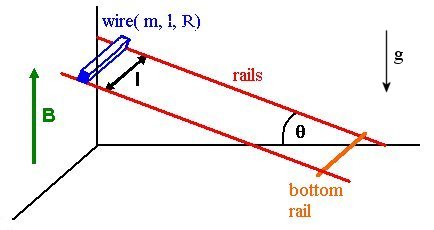
Solution:
- Concepts:
Motional emf
- Reasoning:
The square wire moves in a constant magnetic field. The filamentary
circuit changes shape.
- Details of the calculation:
For a well-defined filamentary circuit which can change its shape we
may write
ε = -d/dt∫B∙dA.
i.e. we can combine the emf due to flux changes and the
emf due to shape changes into one equation.
(a) The wire and the rails
form a circuit. The flux through this circuit if F = BAcosθ.
A is the area of the circuit.
Let us use SI units. Then ε
= -dF/dt, = -(Bcosθ l)(ds/dt) = -Bcosθ lv. Here l is the length of the wire.
I = |ε|/R.
I = Bcosθ lv/R, the current flows counterclockwise when looking from above for a
wire moving down the rail.
The component of the Lorentz force on the rod in the direction opposite to the velocity is FL
= I l Bcosθ
= B2l2vcos2θ/R.
The
gravitational force is mgsinθ
in the direction of the velocity, for a wire sliding down the rail.
Ftot =-B2l2vcos2θ/R + mgsinθ.
Ftot = mdv/dt.
For dv/dt = 0 we need B2l2vcos2θ/R
= mgsinθ, v = R m g tanθ/(B2l2cosθ).
(b) v(π/3)/v(π/6)
= tan(π/3)cos(π/6)/(tan(π/6)cos(π/3) = 5.2
(v(π/3) - v(π/6))/v(π/3)
= 0.8
Percentage change: 80%
(c) Once the wire moves with
constant speed, the rate at which gravitational potential energy is converted
into thermal energy is P = mgdh/dt = mgvsinθ.
P ∝ tan2θ.
(P(π/3) - P(π/6))/P(π/3)
= 0.89
Percentage change: 89%
Problem:
A rod of length L, lying in the xy-plane, pivots with constant
angular velocity ω counterclockwise
about the origin. A constant magnetic field of magnitude B0 is
oriented in the z-direction. Find the motional emf in the rod.
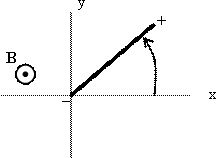
Solution:
- Concepts:
Motional emf
- Reasoning:
The conducting rod is moving in a plane perpendicular to
B.
- Details of the calculation:
Speed of the rod as a function of the distance r from the origin: v(r) = ωr.
Force on an electron: Fe = qevB = qeBωr.
Work done per unit charge: emf = Bω∫0Lrdr
= BωL2/2.
Problem:
One end of a conducting rod rotates with constant angular velocity ω in a circle of
radius r making contact with a horizontal, conducting ring of the same radius.
The other end of the rod is fixed. Stationary conducting wires connect the
fixed end of the rod (A) and a fixed point on the ring (B) to either end of a
resistance R. A uniform vertical magnetic field
B passes through the ring.
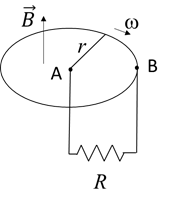
(a) Find the emf produced in the system and its time dependence. [Hint: find
Lorentz force acting on the charges in the moving rod].
(b) Determine direction of current flows in the circuit.
(c) Determine work needed to rotate the rod for one full turn.
Solution:
- Concepts:
Motional emf
- Reasoning:
The conducting rod is moving in a plane perpendicular to B.
- Details of the calculation:
(a)
Speed of the rod as a function of the distance r' from the origin: v(r') = ωr'.
Force on an electron: Fe = qevB = qeBωr'.
Work done per unit charge: emf = Bω∫0rr'dr' =
Bωr2/2.
The emf does not depend on time.
(b)
The direction of the force on an electron is outward.
The current flows from the ring through the rod towards the center.
(c) Assume that the resistance of the conducting rod
and the wires is negligible.
I = emf/R = Bωr2/(2R) is the current flowing through the resistor.
Pe = I2R = B2ω2r4/(4R) is
the rate heat is generated.
W = PeT = Pe2π/ω = πB2ωr4/(2R)
is the work needed to rotate the rod for one full turn.
Problem:
(a) A long solenoid of length L is wound with N turns of wire that
carry a current I. A copper disk of radius a rotates with angular velocity
ω about a shaft at the center of the solenoid as shown in the figure below.
What is the potential difference between slip rings on the shaft and on the edge
of the disk?
(b) Assume L = 1 m, a = 10 cm, N = 1000, I = 2 A and the disk rotates 1200
revolutions per minute. Calculate the potential difference in Volts.
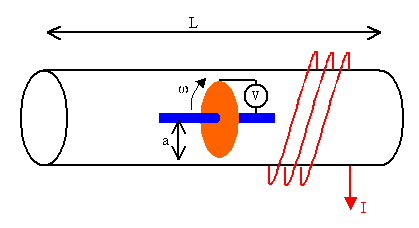
Solution:
- Concepts:
Motional emf
- Reasoning:
Electrons in the disk are moving in circular orbits in a plane
perpendicular to the magnetic field inside the solenoid.
- Details of the calculation:
(a) Use the orientation of the coordinate axes as shown below.

The magnetic field inside the solenoid is B = μ0I(N/L)k
= Bk.
An electron a distance ρ from the center of the disk is moving with velocity
v = -ρω (φ/φ)
and feels a magnetic force Fm = -qev × B = qeρωB
(ρ/ρ).
In equilibrium this force is balanced by an electric force
Fe
= -Fm.
We therefore have a difference in electrostatic potential energy of the
electron
ΔU = Urim - Ucenter = -∫0aFe∙dr
= ∫0aFedr
ΔU = ∫0aqeρωBdρ = qea2ωB/2.
ΔV = Vrim - Vcenter = ΔU/(-qe) = -a2ωB/2
= -a2ωμ0I(N/2L)
(b) ΔV = -(0.1 m)2 2π (1200/(60 s)) (1000/(2 m)) 2A (4*10-7
N/A2) = -1.58*10-3 V.
The rim is at a lower potential than the center.
Problem:
(a) A thin copper plate of mass m has a shape of a square with a side b and
thickness d. The plate is suspended on a vertical spring with a force constant
k in a uniform horizontal magnetic field B parallel to the plane of the plate.
Find the period of the small-amplitude vertical oscillations of the plate.
Neglect the resistivity of the plate.

(b) A bar of mass m is suspended horizontally on two vertical springs with the
force constants k and 3k. The bar bounces up and down while remaining
horizontal. Find the period of oscillations of the bar. Neglect the mass of
the string that connects the springs and the friction between the string and the
pulley.
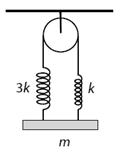
Solution:
- Concepts:
Small oscillations, motional emf
- Reasoning:
(a) In addition to energy being stored in the spring, there is also energy
stored in the separated charge on the plate.
(b) Since the bar remains horizontal at all times, the forces exerted by
each of the springs always have equal magnitudes.
- Details of the calculation:
(a) Consider the plate at an instant that it is moving vertically downward
with velocity v. The motional emf (Hall voltage) produced is ε = Bvd.
The front square face of the plate will become positively charged, and the
back face will have a negative surface charge density of equal magnitude and
opposite sign. We thus have a parallel-plate capacitor with capacitance C =
ε0b2/d.
The energy stored in this capacitor is UE = ½Cε2 = ½ε0b2B2v2d.
Let the y-axis point downward.
dUE = -FEydy, FEy = -dUE/dy = -ε0b2B2d
(v dv/dy) = -ε0b2B2d (v dv/dt dt/dy) = -ε0b2B2d
a.
Newton's second law: ma = -ε0b2B2d a - ky.
(m + ε0b2B2d) d2y/dt2
= -ky.
y = y0cos(ωt + φ) , ω2 = k/((m + ε0b2B2d).
T = 2π/ω = 2π[(m + ε0b2B2d)/k]½.
(b) Assume that the bar has an instantaneous displacement y below its
equilibrium position. The total elongation of both springs together is then
2y. If the individual springs are stretched by y1 and y2
then y1 + y 2 = 2y.
We have y1 = F/(3k) and y2 = F/k, so y2 =
3y1 and y1 = ½ y, y2 = (3/2 )y.
The effective spring constant is keff = 2F/y = 2ky2/y
= 3k.
The period of oscillation therefore is T = 2π/ω = 2π[(m/(3k)]½.









